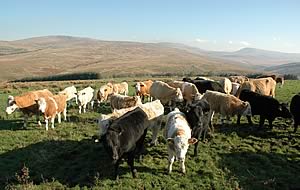 |
|||||||||
|
|||||||||||||||||||
|
|
Do
breeders know their real calving percentage? Too few suckled calf breeders know their true calving percentage and in an effort to raise awareness of the problem the National Beef Association is to distribute a simple calculation formula to its members.
“Profitable beef production begins with a fertile cow and management appreciation of the losses caused by barren animals, slipped pregnancies, dead calves and a straggling calving period,” explained Philip Dale chairman of the Association's cattle health committee. “We want to draw breeders' attention to the economic damage triggered by conditions like leptospirosis , BVD, Johnes ', selenium deficiency, campylobacter, neospora , and salmonella which undermine fertility and inhibit full term pregnancy.” “But first the farmer must know exactly where he sits in the fertility league table and how much effort he needs to make to stand level with the breeder who will harvest around nine calves each year from every ten cows bulled or reach a higher level of about 95 per cent.” According to the NBA one of the problems is defining a consistent calculation formula which could become common national currency when measuring individual herd fertility and breeding performance - as is the case with lambing percentages. “Some farmers count the cows bulled and then calves sold without asking themselves how many of their cows calve within 390 days of their last calf,” said Mr Dale. “Others do not include cows sold off as barren but include in-calf cows, or cows with calves at foot that they have bought in as replacements, while some include dairy cross calves that have been brought in to replace a dead one.” “We want to raise awareness by printing a simple self assessment form which merely asks how many cows there are on the farm, how many calves were born dead or aborted, how many cows were culled as barren and how many weaned calves were sold - all over a given 12 month period” “The next step would be to identify how many cows are in-calf after two chances with the bull, how many calve within 390 days of their last calf and the true length of the calving period.” “The latter could be a bit of an eye opener because many farms run spring calving herds which breed from February to June, have another group which calves from August to December and constantly exchange cows between them which may only produce a calf every 18 months.” “The ideal would be to calve the entire herd within 10 weeks and calve all cows within 390 days of their last calf and now that poor breeders can be sold for more money commercially instead of being kept back because of poor OTM prices there is a better chance of sub-fertile cows being culled out.” “Once a template against which commercial performance can be measured more farmers will be in a position to decide if the income damage they endure through infertility can be cut by reducing, or eliminating, specific diseases and other management improvements.” “For some farmers our herd infertility self-assessment form could be the first step in this process,” Mr Dale added. For more information contact: Philip Dale, NBA cattle health committee chairman. Tel. 01953 717176 Kim-Marie Haywood, NBA policy advisor. Tel. 0131 336 1754
|
||||||||||||||||||

|
|
||||||||||||||||||
| home | agri-services | pedigree
pen | news | dairy | beef | machinery property | organisations | site map |
|||||||||||||||||||

